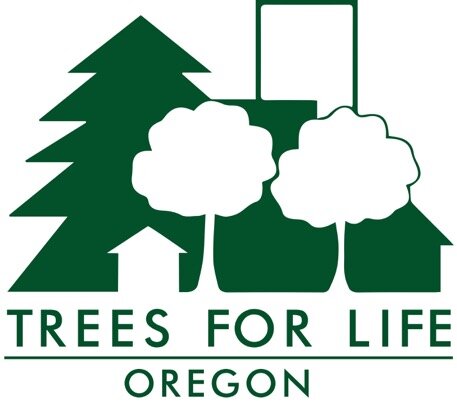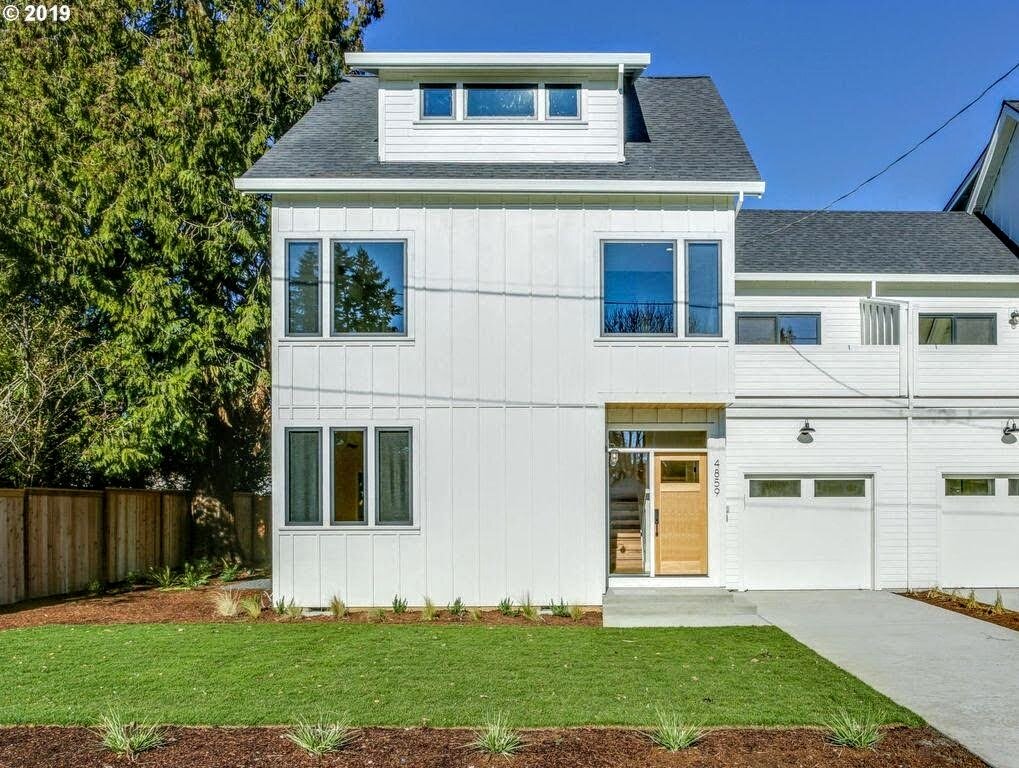Ethan Beck of Ethan Beck Homes
A Designing for Trees Feature By Kyna Rubin
Trees For Life showcases the creativity and thought processes of developers and architects who are taking the time to design buildings with trees in mind. Their work, which preserves or creates space for trees, illustrates that new development and trees need not be mutually exclusive.
February 12, 2020
It’s worth it to preserve large trees on his properties, finds Ethan Beck. But the City of Portland puts him in a difficult spot when the Portland Bureau of Transportation (PBOT) and Urban Forestry provide conflicting rulings. At a time of climate crisis, might these and other city bureaus better coordinate around protecting large trees?
"Maintaining large trees on the properties he develops is so important to Beck that he’ll pass up projects that would require a big-tree teardown."
The home Beck built next to Save the Giants Park on SE Martins Street. Photo: Trees for Life Oregon
Every project he’s done is better for having worked with existing trees, says developer Ethan Beck, who grew up in Vermont, moved to Portland in 2002, and formed his eponymous company in 2007. He might spend a bit more for an arborist to preserve a large tree, but the end product, he says, is that “you saved this great tree that adds to the value of the neighborhood and the site itself.”
Beck first determines a tree’s health to find out if it’s worth preserving. One of the go-to tools his arborist uses is a sonogram, almost like a radar, to check the tree’s density to make sure there’s no internal decay. According to arborist and Trees for Life member Bruce Nelson, older, cheaper methods such as small-diameter drilling or tapping the trunk with a rubber mallet can be damaging or imprecise, respectively.
When he wants to design a house that’s 20 feet or less from the tree, Beck figures out “before we even go into permitting” how close he can get to the tree with his construction equipment without affecting its roots. His arborist will check the root spread depth and pattern, which can be unpredictable because every tree is different. Beck usually relies on air spading, a high-pressure air gun that blows the dirt away while leaving the roots intact and, he says, is much less disruptive to tree roots than a shovel.
Working Around Giant Sequoias and Western Redcedars
In 2015 Beck built a house (see above) on SE Martins Street near 36th Avenue on a lot just west of the three roughly 130-year-old giant sequoias that Save the Giants put so much effort into preserving. A previous developer had purchased that lot and the one next door with the sequoias; he had demolished the home that had been on the first lot and planned to raze the nearby three redwoods. To save the trees, neighbors banded together to buy both lots from the developer, but the terms of the sale, says Beck, required a partner. The residents teamed up with Beck because they knew he was a developer who was willing to build around trees. The group of neighbors purchased the lot with the sequoias, and Beck the lot next to it.
Left: The two western redcedars, which look like one here, whose roots Beck protected by shrinking the lower floor plan for the SE 36th and Bybee home. The added upper floor bump-out is opposite the trees. Photo: Armin Hinterwirth. Right: Beck's revised lower floor plan, with the new cantilevered bump-out on right. Courtesy of Ethan Beck.
The home that had been taken down by the previous developer already had a deep foundation on the east side, near the sequoias. Beck designed his new home to fit into the previous house’s footprint, where roots were not present, avoiding new excavation on that side of the property. As a result, he says, his construction had as small an impact as possible on the giant sequoia closest to the house.
Tweaking foundation design and placement to keep roots intact is another means Beck uses to preserve and protect trees. To safeguard the roots of two 26-inch DBH (diameter at breast height) western redcedars at a home he built in 2011 near SE 36th and Bybee Boulevard, he shifted the house foundation farther away from the trees than originally intended, redesigned the lower floor layout to accommodate a slightly smaller footprint, and added a cantilevered bump-out on the upper floor. “We love the two cedars next to our house,” says homeowner Armin Hinterwirth. “We look right out at their lower branches when sitting at our dinner table.”
Beck has been in the situation “where the city forester wants a tree to be saved and PBOT wants the road widened, and the tree has to go. So what do you do there?” he asks.
The western redcedar, on left, that Beck preserved next to the house on SE Tolman. Photo: Courtesy of Ethan Beck
More recently, in 2018, Beck preserved a western redcedar just 10 feet from a new home near SE 48th and Tolman through careful arborist monitoring, and again, by slightly shrinking the lower floor footprint. To run utility lines, which owing to space constraints had to snake beneath the tree, he bore laterally rather than dig a trench. “It’s horizontal drilling as opposed to digging down and laying pipe. It’s more expensive but it’s fast, it’s clean, and it’s worth it,” he says. It may seem implausible that any boring near a tree is safe, but according to Bruce Nelson, most tree roots in urban settings are only 20 inches deep. Boring to lay eight-inch-diameter utility lines below the roots requires removing much less soil than laying deep pipe would, and is minimally disruptive.
On a few other projects, to prevent damage to nearby trees Beck has mounted foundations on hand-dug posts placed on pilings.
Maintaining large trees on the properties he develops is so important to Beck that he’ll pass up projects that would require a big-tree teardown. One day he drove by a 5,000-foot lot dug into a hillside with a beautiful Douglas-fir tree smack in the middle. “I just kept driving,” he says. It’s not that he hasn’t taken trees down, he adds, but they’ve been smaller, less significant ones.
Conflicting Advice from PBOT and Urban Forestry
Beck has been in the situation “where the city forester wants a tree to be saved and PBOT wants the road widened, and the tree has to go. So what do you do there?” he asks. A bigleaf maple on one of his SE properties is a case in point. For a road widening, PBOT required the developer to build a retaining wall where the tree was, so the tree had to come out. According to Beck, his arborist said to him, “We need to figure this out because there’s no way I’m cutting this thing down.” They designed a retaining wall that was shorter in length and height than what PBOT was asking for, placed it away from the tree, and did the air spade work to ensure that the proposed wall would not impact the maple’s roots. Then, like developer Eli Spevak has done to preserve large trees, Beck applied to PBOT for a variance. After a few months of “touch and go” and much back and forth, his application was approved. Having won the battle to preserve the tree, he then pruned it because it had been neglected. The variance cost time and money, but “if it’s a priority,” says Beck, “it’s obtainable.”
However, at a different property, off of SE Hawthorne, which at the time Beck was not developing himself but providing advice on, a PBOT variance he suggested to jog the sidewalk around a 26-inch DBH sweet gum was not successful. PBOT rejected the application and the tree was lost. That outcome might have been due to the fact that sweet gums are notoriously shallow-rooted and tend to lift up sidewalks, and that, according to Beck, this tree occupied space that PBOT required to be dedicated to the right of way.
Separate from PBOT issues, Beck is comfortable dealing with the tree code. On the same sweet gum site, which comprises four lots on which he will build two attached and two detached single-family homes, he’s preserving a 32-inch DBH western redcedar and a 24-inch DBH honey locust using the code’s “performance path.” This option permits him to encroach upon the prescribed root protection zones as long as he produces the documentation showing he can do so without harming the trees. The code allows him to include these trees in its calculation of the site’s mandated tree minimum. Moreover, Beck says he saves more trees than he’s obliged to. If a tree he’d like to preserve is 10 feet or less from one of his houses, which code does not require him to keep, “we won’t identify that as one we’re going to save, yet we’ll still save it.”
Suggestions for the City
Beck says he’ll never be “a pro” on the tree code. He hires people who are. But he wishes Title 11 were easier to understand. “I think simple is better.” And though he understands that PBOT has ADA, liability, and transportation concerns, “it would be great if Urban Forestry and PBOT’s agendas were more in line. They should be working together to save trees.”



